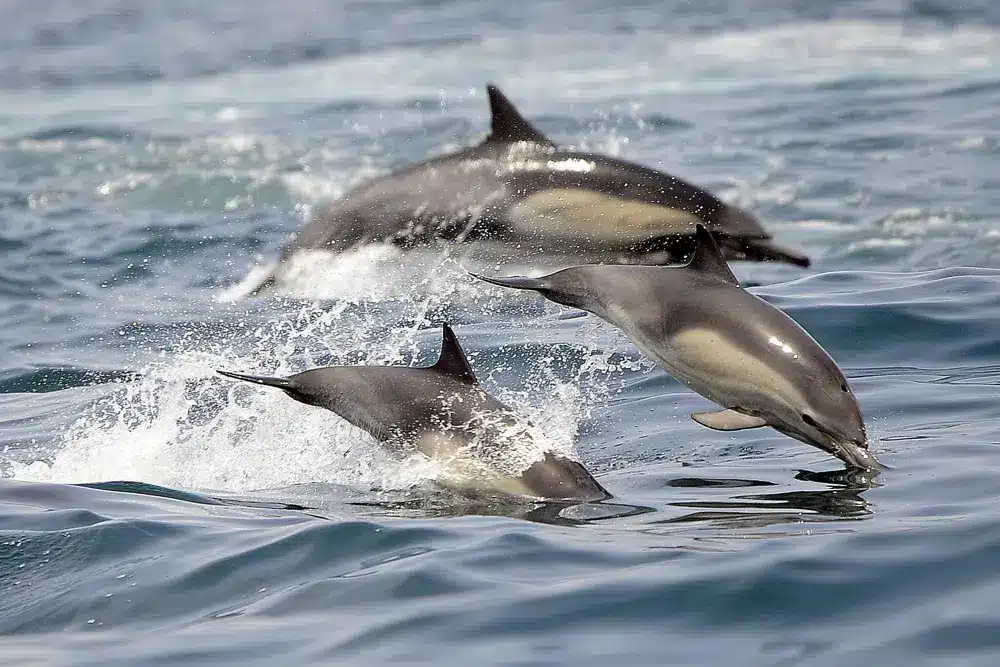Science
UN Ocean Treaty Talks Resume With Goal To Save Biodiversity

United Nations members gather in New York on Monday to resume efforts to forge a long-awaited and elusive treaty to protect the world’s marine biodiversity.
On the high seas, nearly two-thirds of the ocean is outside national borders, where fragmented and unevenly enforced rules seek to minimize human impacts.
The United Nations meetings, which will last until March 3, aim to produce a unified agreement for the conservation and sustainable use of those vast marine ecosystems. The talks, formally known as the Intergovernmental Conference on Marine Biodiversity of Areas Beyond National Jurisdiction, resume talks that were halted last fall due to a lack of agreement on a final treaty.
“The ocean is our planet’s life support system,” said Boris Worm, a marine biologist at Canada’s Dalhousie University. “We didn’t feel we had much impact on the high seas for a long time. But that has changed as deep sea fishing, mining, plastic pollution, climate change, and other human disturbances have increased.
The United Nations talks will center on key issues such as who should draw the boundaries of marine protected areas and how. How should institutions evaluate the environmental consequences of commercial activities like shipping and mining? And who has the authority to enforce the rules?
An Agreement Is Urgently Needed To Save The Oceans And Our Planet
“This is our largest global commons,” said Nichola Clark, an oceans expert for the nonpartisan Pew Research Center in Washington, D.C. “We are optimistic that the next round of negotiations will result in a treaty being signed.”
The talks’ goal is not to designate marine protected areas but to create a mechanism for doing so. “The goal is to create a new organization that will accept submissions for specific marine protected areas,” Clark explained.
According to marine biologist Simon Ingram of the University of Plymouth in England, an agreement is urgently needed. “It’s a pressing time for this, especially with things like deep-sea mining that could be a real threat to biodiversity before we’ve even surveyed and understood what lives on the ocean floor,” Ingram said.
Experts believe a global oceans treaty is required to enforce the United Nations Biodiversity Conference’s recent pledge to conserve 30% of the planet’s oceans and land.
“We need a legally binding framework that allows countries to work together to achieve these agreed-upon goals,” said Jessica Battle, an oceans governance expert at the World Wide Fund for Nature.
United Nations Is Working Hard To Keep Peace And Protect The World
According to Monica Medina, Assistant Secretary of State for Oceans and International Environmental and Scientific Affairs, the treaty is a priority for the United States. “For the first time, this agreement seeks to establish a coordinated approach to establishing marine protected areas on the high seas,” she explained. “It’s time to complete the task.”
Officials, environmentalists, and representatives of global industries that rely on the sea are all keeping a close eye on the negotiations.
Gemma Nelson, a Samoan lawyer and Ocean Voices fellow at the University of Edinburgh, stated that small Pacific and Caribbean island countries were “especially vulnerable to global ocean issues” such as pollution and climate change, which they did not cause and did not have the resources to easily address.
“Getting the traditional knowledge of local people and communities recognized as valid,” she added, is also critical to protecting ecosystems and Indigenous groups’ ways of life.
With high seas covering nearly half of the planet’s surface, the talks are critical, according to Gladys Martnez de Lemos, executive director of the nonprofit Interamerican Association for Environmental Defense, which focuses on environmental issues in Latin America.
“The treaty should be strong and ambitious, with authority to establish high and fully protected high seas zones,” she said. “At the United Nations these weeks, half of the world is at stake.”
SOURCE – (AP)
Science
A Spacecraft Is On Its Way To A Harmless Asteroid Slammed By NASA In A Previous Save-The-Earth Test

CAPE CANAVERAL, Florida – A spacecraft launched Monday to probe the site of a cosmic accident.
The European Space Agency’s Hera spacecraft launched on a two-year trip to the little, harmless asteroid slammed by NASA two years ago as a practice run for the day when a murderous space rock threatens Earth. It’s the second phase of a planetary defense experiment that could one day save the globe.
SpaceX’s Falcon rocket vanished with Hera into the late morning clouds. An hour later, cheering erupted in the control center in Germany as the spacecraft split from the rocket’s upper stage and returned home. “It’s an amazing day,” the space agency’s director general, Josef Aschbacher, said later.
The 2022 crash of NASA’s Dart spacecraft reduced Dimorphos’ orbit around its larger companion, indicating that if a harmful rock was heading our way, it might be pushed off course with adequate warning.
nasa
A Spacecraft Is On Its Way To A Harmless Asteroid Slammed By NASA In A Previous Save-The-Earth Test
Scientists are eager to analyze the aftermath of the impact up close to determine how effective Dart was and what improvements may be required to protect Earth in the future.
“The more detail we can glean the better as it may be important for planning a future deflection mission should one be needed,” University of Maryland astronomer Derek Richardson stated before launch.
Researchers want to know if Dart (short for Double Asteroid Redirection Test) created a crater or changed the 500-foot (150-meter) asteroid more dramatically. It seemed to be a flying saucer before Dart’s blow and may now resemble a kidney bean, according to Richardson, who participated in the Dart mission and is assisting Hera.
Dart’s wallop sent rubble and boulders hurtling off Dimorphos, adding to the impact’s momentum. For months, the debris track extended thousands of miles (almost 10,000 kilometers) into space.
According to flight director Ignacio Tanco, some rocks and debris may still be hovering about the asteroid, posing a threat to Hera.
A Spacecraft Is On Its Way To A Harmless Asteroid Slammed By NASA In A Previous Save-The-Earth Test
“We don’t really know very well the environment in which we are going to operate,” Tanco informed me. “But that’s the whole point of the mission is to go there and find out.”
European authorities refer to the $400 million (363 million euros) effort as a “crash scene investigation.”
“Hera is going back to the crime scene and getting all the scientific and technical information,” said project manager Ian Carnelli.
Carrying a dozen science instruments, the compact car-sized Hera must swing past Mars in 2025 for a gravitational boost before landing at Dimorphos by the end of 2026. It’s a moonlet of Didymos, the Greek word for twin, a five-times larger asteroid that spins quickly. At that point, the asteroids will be 120 million miles (195 million kilometers) from Earth.
Hera will attempt to enter orbit around the rocky duo, progressively reducing flyby distances from 18 miles (30 kilometers) to a half-mile (1 kilometer). The spacecraft will examine the moonlet for at least six months to determine its mass, shape, composition, and orbit around Didymos.
Before the crash, Dimorphos circled its larger partner from three-quarters of a mile (1,189 meters) away. Scientists believe the orbit has become tighter and more oval-shaped, and that the moonlet may be tumbling.
Two shoebox-sized Cubesats will launch from Hera for even closer drone-like examinations, with one employing radar to peek beneath the moonlet’s boulder-strewn surface. Scientists believe Dimorphos was produced from particles shed by Didymos. The radar measurements should assist in determining whether Didymos is the small moon’s parent.
A Spacecraft Is On Its Way To A Harmless Asteroid Slammed By NASA In A Previous Save-The-Earth Test
After their survey, the CubeSats will attempt to land on the moonlet. If the moonlet tumbles, the situation will become more complicated. Hera may potentially conclude its mission with a perilous touchdown but on the bigger Didymos.
Asteroids, which are remnants of the solar system’s origin 4.6 billion years ago, circle the sun principally between Mars and Jupiter in what is known as the main asteroid belt, where millions of them live. When they fall from the belt and land in our area, they become near-Earth objects.
NASA now has around 36,000 near-Earth objects, the majority of which are asteroids, although there are also some comets. More than 2,400 of them are deemed potentially dangerous to the Earth.
SOURCE | AP
Science
A Rare Comet Brightens The Night Skies In October

NEW YORK — Prepare to spot a rare and dazzling comet.
The space rock is hurling toward Earth from the far reaches of the solar system and will make its closest approach on Saturday. It should be visible through the end of October, assuming clear skies.
A Rare Comet Brightens The Night Skies In October
Comet Tsuchinshan-Atlas should be visible to the naked eye, but binoculars and telescopes will provide a clearer view.
“It’ll be this fuzzy circle with a long tail stretching away from it,” explained Sally Brummel, planetarium manager at the Bell Museum in Minnesota.
What is a comet?
They are frozen remains from billions of years ago when the solar system was formed. They heat up as they swing toward the sun, revealing their distinctive streaming tails.
In 2023, a green one that had last visited Earth 50,000 years ago flew past again. Other significant flybys were Neowise in 2020 and Hale-Bopp and Hyakutake in the mid to late 1990s.
Where did Tsuchinshan-Atlas come from?
Also known as C/2023 A3, was found last year and named after the observatories in China and South Africa that spotted it.
It originated in the Oort Cloud, which extends far beyond Pluto. After making its closest approach to Earth at 44 million miles (71 million kilometers), it will not return for another 80,000 years, provided it survives the journey.
A Rare Comet Brightens The Night Skies In October
Every year, several comets are detected, but many of them burn up near the sun or are too far away to be observed without special equipment, according to Larry Denneau, a key researcher with the Atlas telescope that helped discover it.
How to View
Those seeking to see Tsuchinshan-Atlas should go outside about an hour after sunset on a clear night and look to the west.
The comet should be visible from both the Northern and Southern Hemispheres.
SOURCE | AP
Science
NASA Switches Off Instrument On Voyager 2 Spacecraft To Save Power

NEW YORK — To save power, NASA turned off another scientific equipment on its long-running Voyager 2 spacecraft.
NASA Switches Off Instrument On the Spacecraft To Save Power
The space agency announced on Tuesday that 2’s plasma science instrument, meant to study the movement of charged atoms, was turned off in late September to allow the spacecraft to continue exploring for as long as possible, which is estimated to be into the 2030s.
NASA turned off a suite of instruments on Voyager 2 and its twin, Voyager 1, after exploring the gas giant planets in the 1980s. Both are currently in interstellar space or the region between stars. The plasma instrument on Voyager 1 stopped working years ago and was finally shut off in 2007.
The remaining four instruments on 2 will continue to collect data on magnetic fields and particles. Its mission is to investigate the regions of space beyond the sun’s protective sphere.
NASA Switches Off Instrument On Voyager 2 Spacecraft To Save Power
It launched in 1977, is the only spacecraft to have visited Uranus and Neptune. It is now more than 12 billion miles (19.31 billion kilometers) from Earth. 1 is more than 15 billion miles (24.14 billion kilometers) beyond Earth.
SOURCE | AP
-
Tech3 weeks ago
Apple Unveiled A Fresh Glimpse Of Their AI Featuring ChatGPT Integration.
-
Tech4 weeks ago
Connection Problems With The App Store Are Stopping Customers From Downloading Apps.
-
Tech4 weeks ago
The Meta Foundation Launches a New Anti-Sextortion Campaign on Instagram.
-
Tech4 weeks ago
Adobe Commences The Implementation Of AI Video Tools, Which Poses A Challenge To OpenAI And Meta.
-
Tech4 weeks ago
Appeals Court Delays Order For Google To Open Its App Store In Antitrust Case
-
Business4 weeks ago
Arthur Hayes Predicts Bitcoin Will “Rise Stupendously” When Middle East Conflict Escalates.
















































